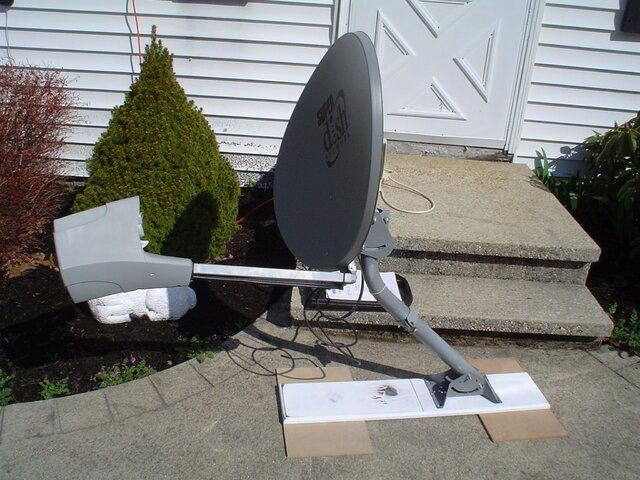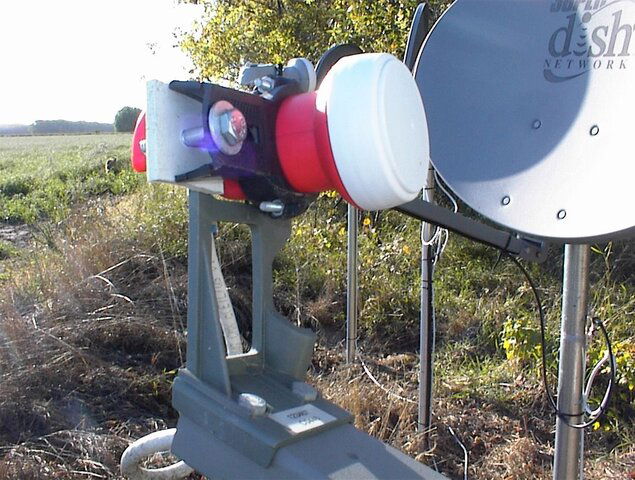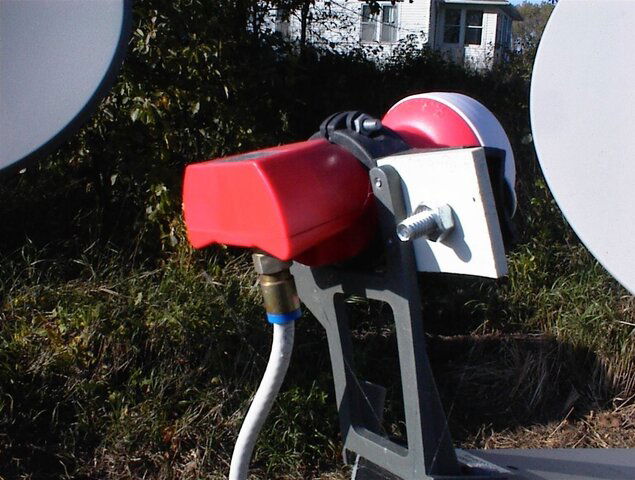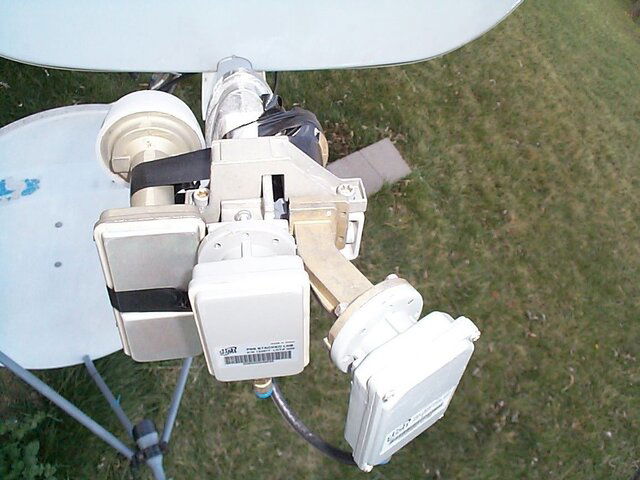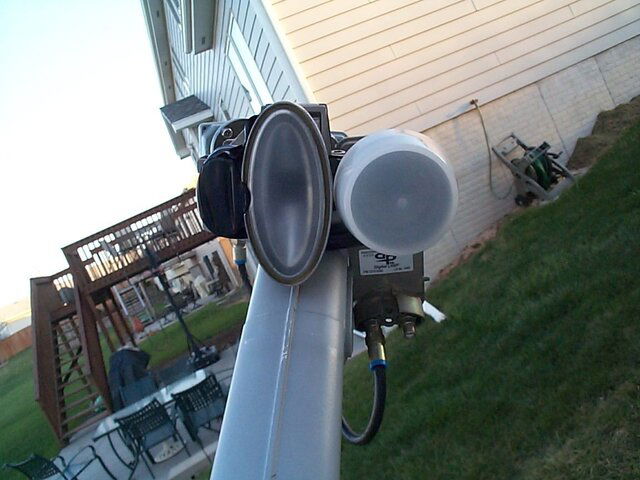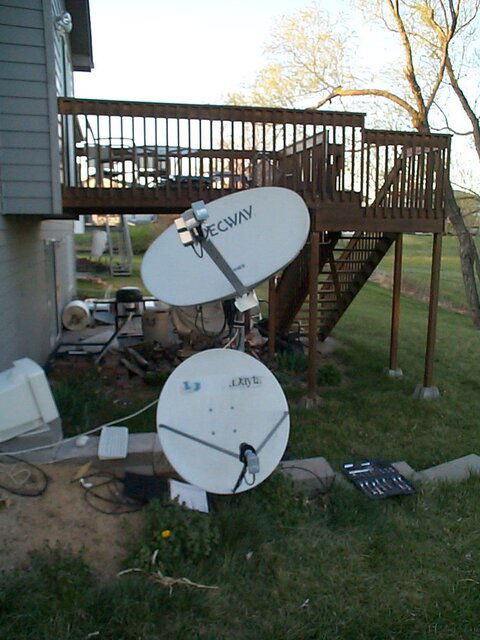A few months ago I got a free direcpc dish and was pretty impressed by its reception.
I put an ad on free-cycle for midsized satellite dishes and was given two identical Super Dish Network dishes. After researching what exactly I had, I read the 125w, two degree threads and the 123w/119w dish mod thread. Someone suggested these two ideas should meet so I thought I'd give it a try.
I removed the cover from one and noticed that there were light gray modules labeled FSS and DBS. I started to wonder if there was any wisdom in just replacing the DBS module with a FSS module. I doubted it would be that simple but thought it was worth a shot. So I removed the FSS module from this donor dish.
When I removed the cover from the second lnbf assembly I almost soiled my pants. Nearly the entire interior was filled with a hornets nest and dead (luckily) hornets poured out onto the floor.
I replaced the DBS module on this dish with the FSS module from the other dish.
For a baseline, I checked out a few of the transponders on 123w and 125w using the signal meter built into my visionsat, and my winegard 76 setup. I found quality to be in the 80's. It was partly cloudy and very windy.
Using the mount that came with one of the dishes I screwed the super dish mount to some wood for a temporary setup. I had a bugger of a time aiming this heavy dish with my light, wooden, ghetto mount but once I did I was able to hit 125w using the original FSS module and oval feedhorn intended for 121w. I found my quality to be in the 80's. With a little adjustment and using the same feedhorn I was able to hit 123w with quality in the 80's as well. I was very impressed by this performance on a free oval dish.
Granted this was hooking the super dish directly to the receiver with less than 6ft of cable. The winegard has a motor in the mix, 100ft of cable and a ground block.
I aimed the oval feedhorn at 125w again and hooked the cable from the round 119w feedhorn to the the receiver which should now be aimed at 123w. I was immediately encouraged by retrojams popping up on the tv. I was able to get quality of about 67% without compromizing the quality in the 80s on 125w. This setup was too floppy to waste time with much more fine tuning.
I did a blind scan on 123w to see what would pop up. The wind was visibly shaking the dish while scanning. The scan found what I believe was KTWO, retrojams and possibly 3CTV (cea or cee?). Curiously it scanned in about four copies of each channel. For instance KTWO was on two different TPs at about 12104 and two different TPs at about 12495.
None of the lower transponders scanned in. I'm guessing this is the fault of the feedhorn although it is possible that these are weaker transponders.
The next time I have free time I will get out the hacksaw and setup both modules with the oval feedhorns.
In the pictures you can see my ghetto dish mount and where I replaced the FSS module. I am holding the DBS module above the FSS module that I replaced.
I put an ad on free-cycle for midsized satellite dishes and was given two identical Super Dish Network dishes. After researching what exactly I had, I read the 125w, two degree threads and the 123w/119w dish mod thread. Someone suggested these two ideas should meet so I thought I'd give it a try.
I removed the cover from one and noticed that there were light gray modules labeled FSS and DBS. I started to wonder if there was any wisdom in just replacing the DBS module with a FSS module. I doubted it would be that simple but thought it was worth a shot. So I removed the FSS module from this donor dish.
When I removed the cover from the second lnbf assembly I almost soiled my pants. Nearly the entire interior was filled with a hornets nest and dead (luckily) hornets poured out onto the floor.
I replaced the DBS module on this dish with the FSS module from the other dish.
For a baseline, I checked out a few of the transponders on 123w and 125w using the signal meter built into my visionsat, and my winegard 76 setup. I found quality to be in the 80's. It was partly cloudy and very windy.
Using the mount that came with one of the dishes I screwed the super dish mount to some wood for a temporary setup. I had a bugger of a time aiming this heavy dish with my light, wooden, ghetto mount but once I did I was able to hit 125w using the original FSS module and oval feedhorn intended for 121w. I found my quality to be in the 80's. With a little adjustment and using the same feedhorn I was able to hit 123w with quality in the 80's as well. I was very impressed by this performance on a free oval dish.
Granted this was hooking the super dish directly to the receiver with less than 6ft of cable. The winegard has a motor in the mix, 100ft of cable and a ground block.
I aimed the oval feedhorn at 125w again and hooked the cable from the round 119w feedhorn to the the receiver which should now be aimed at 123w. I was immediately encouraged by retrojams popping up on the tv. I was able to get quality of about 67% without compromizing the quality in the 80s on 125w. This setup was too floppy to waste time with much more fine tuning.
I did a blind scan on 123w to see what would pop up. The wind was visibly shaking the dish while scanning. The scan found what I believe was KTWO, retrojams and possibly 3CTV (cea or cee?). Curiously it scanned in about four copies of each channel. For instance KTWO was on two different TPs at about 12104 and two different TPs at about 12495.
None of the lower transponders scanned in. I'm guessing this is the fault of the feedhorn although it is possible that these are weaker transponders.
The next time I have free time I will get out the hacksaw and setup both modules with the oval feedhorns.
In the pictures you can see my ghetto dish mount and where I replaced the FSS module. I am holding the DBS module above the FSS module that I replaced.


